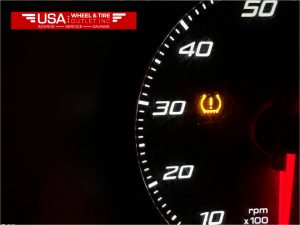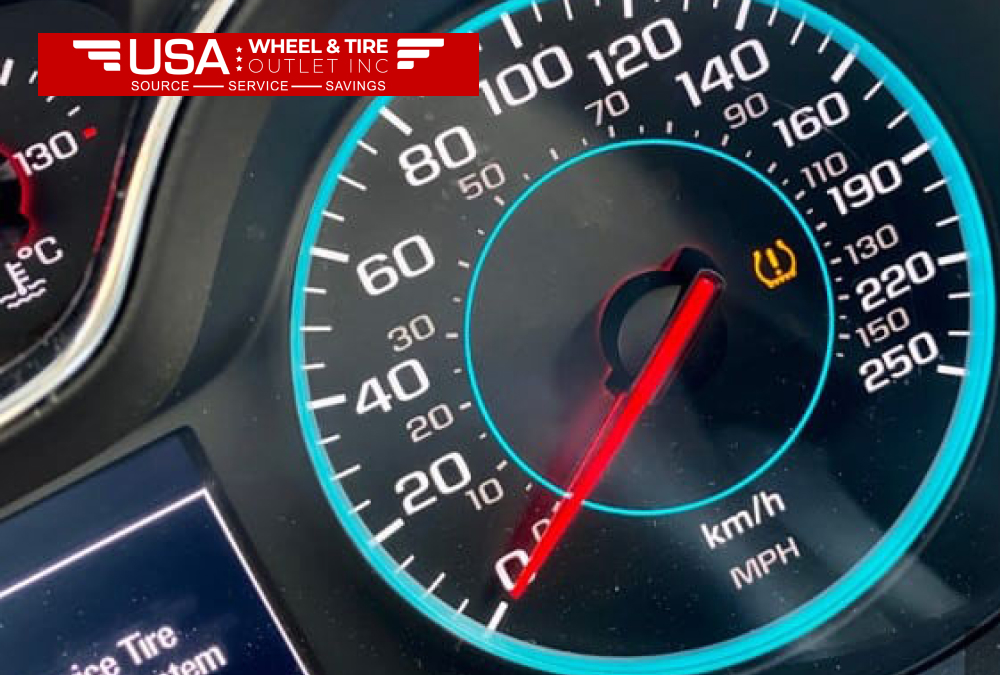If you have seen the “Service Tire Monitor System” warning light on your dashboard, you must wonder what it means and how to fix it. This warning light ties to your vehicle’s Tire Pressure Monitoring System, which alerts for any tire pressure problems with the potential to influence not only the safety but also the performance of your automobile.
Understanding what this warning light means can help you maintain proper tire pressure, improve fuel efficiency, and avoid tire-related problems. In this article, we will dive into the details of the “Service Tire Monitor System” warning light, what causes it to turn on, and how you can troubleshoot and fix it.
What Is the Tire Pressure Monitoring System (TPMS)?
Before we delve into the nature of the warning light itself, let’s first comprehend what the Tire Pressure Monitoring System (TPMS) is. TPMS represents a system fitted in modern motor vehicles to monitor the air in each tire. It intends to inform you when its pressure has fallen below a safe threshold, since improper pressure can lead to poor handling efficiency, lower fuel efficiency and even blowouts.
There are two major categories of TPMS systems:
Direct TPMS: The sensors measure the pressure inside each tire. When the pressure is below a certain threshold, the warning light is triggered.
Indirect TPMS: This type of TPMS measures tire pressure indirectly by tracking the rotation of the tires with the vehicle’s speed sensors. When one of the tires rotates at a rate that is different from the others, indicating low pressure, it triggers the warning light.
If the system finds anything wrong, it can prompt a warning light on your dashboard reminding you to check your tires.
What does ‘Service Tire Monitor System’ Warning Light Signify?
This is known as the “Service Tire Monitor System” warning light.
The warning light indicates that there’s an issue with the TPMS of your vehicle. It differs from the standard tire pressure warning light, which simply indicates low tire pressure, but in this case, there could be an internal malfunction with the TPMS itself.

Here are some common causes for the warning light:
1. Low Tire Pressure: The most common cause is still low tire pressure. If any tire is underinflated, the TPMS may trigger the warning light.
2. Issues with the TPMS Sensor: The warning light may appear if one or more of the TPMS sensors are faulty or damaged. These sensors are responsible for sending tire pressure data to the vehicle’s onboard computer. If they fail, the system cannot monitor tire pressure correctly.
3. Dead TPMS Sensor Battery: The batteries that power TPMS sensors last around 5-10 years. Dead batteries of the sensor may even trigger the warning light.
4. Tire Rotation: If you recently rotated the tires or replaced them, the TPMS system is probably not recalibrated; this might trigger the warning light to turn on.
5. Tired out Tires: When the tire is worn down, the system may not read the pressure right in the tire and may, therefore, switch on the warning light.
6. Aftermarket Wheels: If you fit aftermarket wheels or tires that have no TPMS sensors installed correctly, this system will automatically send on the warning light because it cannot even read the pressure in your tires.
7. Faulty In-Vehicle TPMS System: In most situations, the problem could be on the in-vehicle system causing it to malfunction.
Troubleshooting the ‘Service Tire Monitor System’ Light On
In According to USA Wheels and Tires INC, If you encounter the “Service Tire Monitor System” light, you can start with troubleshooting the problem prior to going to a mechanic.

Just follow these steps:
1. Inflate Tires
Check tire pressure. Utilize a tire pressure gauge and be sure to inflate all of your tires to the levels set forth by the manufacturer, typically a sticker can be found in the door frame inside your driver’s door. Pump each low tire to correct pressure
If you pass with this step move on.
2. Examine TPMS Sensors
If the tire pressure is okay, then there might be a problem with the TPMS sensors. If one of the sensors is damaged or malfunctioning, the system will trigger the warning light. You can check the sensors visually, but it’s best to have a professional check them using specialized equipment that can read the sensor codes.
3. Reset the TPMS
Sometimes, simply resetting the TPMS can resolve the issue. The procedure for resetting the TPMS differs between makes and models, so you may want to refer to your owner’s manual for further instructions. Often, you can reset the system by turning the ignition on but not starting the engine, then holding down the TPMS reset button, which is usually found below the steering wheel, for a few seconds.
4. Dead TPMS Sensor Batteries
If your vehicle is older, the TPMS sensors may have dead batteries. Unfortunately, these sensors aren’t designed to have their batteries replaced easily. In most cases, you’ll need to replace the entire sensor, which may require professional assistance.
5. Recalibrate After Tire Rotation
If you just rotated your tires, you will likely need to re-calibrate the TPMS system so that it accounts for the new locations of the tires. Some cars will auto-re-calibrate after you have driven a few miles. Other vehicles require that you do it manually in the car’s settings.
6. Look for aftermarket tires or wheels
If you have replaced your tires or wheels with aftermarket parts, make sure that they are compatible with your vehicle’s TPMS. If your new wheels do not have TPMS sensors installed, this could trigger the warning light.
7. See a Mechanic
If the light persists even after the troubleshooting steps mentioned above, then it’s time to see a professional mechanic or tire specialist. They will diagnose the problem in your TPMS system and repair it.
How to Fix the ‘Service Tire Monitor System’ Warning Light
If you suspect the problem and want to clear the “Service Tire Monitor System” warning light, you’ll find that the solutions differ with the cause. Here are some possible remedies:
1. Replace Faulty TPMS Sensors
If your TPMS sensors are defective or have gone faulty, changing them will probably solve the problem. You may need to go to a tire shop or to a mechanic to get your sensors replaced.
2. Replace Dead TPMS Sensor Batteries
If the batteries in your TPMS sensors are dead, the sensors will need to be replaced. This process can be a bit costly, as it involves removing the tires and replacing the sensors.
3. Reinflate or Replace Tires
If the issue was low tire pressure or worn-out tires, reinflating the tires or replacing them will resolve the warning light. Be sure to check the pressure regularly to avoid future issues.
4. Calibrate the TPMS
If the light is due to a tire rotation or wheel change, recalibrating the TPMS may fix the problem. You can usually reset or recalibrate the system yourself by referring to the instructions in your vehicle’s manual.
Prevention of ‘Service Tire Monitor System’ Warning Light Problems
To avoid having the “Service Tire Monitor System” warning light come on, you can take the following preventive measures:
Monitor the Tire Pressure: Monitor your tire pressure. Monitor it by a tire pressure gauge regularly, but especially before a long journey.
Maintain the TPMS: Let your TPMS be checked during regular maintenance of the vehicle to make sure that it is in proper working condition.
Change the Worn Tires: Change your tires if they are worn out or damaged. Check their tread depth and general conditions.
Use OEM Parts: When you are replacing tires or wheels, ensure that you use original equipment manufacturer (OEM) parts compatible with your vehicle’s
TPMS.
Conclusion
The “Service Tire Monitor System” warning light indicates that there is a malfunction in your vehicle’s Tire Pressure Monitoring System. It could possibly be a sign of low pressure in the tires, an issue with the TPMS sensors, or other related problems. You can find solutions to most of these issues just by following the troubleshooting guidelines provided above or seek professional service when necessary.
Always keep your tire pressure in the proper state to ensure your vehicle is safe and runs smoothly. Never fail to address tire pressure concerns and be in control of your TPMS system to prevent any potential problems.
Read Also: Radar Tires MT: Affordable Performance for Off-Roading
Frequently Asked Questions (FAQs)
1. What is the meaning of the ‘Service Tire Monitor System’ warning light?
This simply indicates that there is a problem with your vehicle’s Tire Pressure Monitoring System (TPMS), most probably sensor-related or due to low tire pressure.
2. Can I diagnose the ‘Service Tire Monitor System’ warning light myself?
Yes, you can check tire pressure, recalibrate the TPMS, or inspect for sensor issues. If the light persists, a mechanic may be needed.
3. Why does my TPMS light come on after a tire rotation?
After rotating tires, the TPMS might need to recalibrate to reflect the new tire positions. This can often be done manually or automatically.
4. How do I reset the ‘Service Tire Monitor System’ warning light?
You can reset the TPMS by following the instructions in your owner’s manual, usually by pressing the TPMS reset button.
5. What if the TPMS sensor battery is dead?
If the sensor’s battery is dead, the sensor needs to be replaced. This typically requires professional help.
6. Why is the ‘Service Tire Monitor System’ light still on after inflating my tires?
If the light remains illuminated after the inflation, a faulty sensor, incorrect tire mounting, or a malfunctioning of the TPMS system can be assumed.
7. How many times should I inspect my tire pressure?
To avoid this TPMS problems, inspect the tire pressure once in every month or a long distance trip.
8. Does ‘Service Tire Monitor System’ warning light on mean the tires are bad?
Not necessarily, but it does tell you that there is a problem with the TPMS. You should fix it to ensure that your tires are safe.





